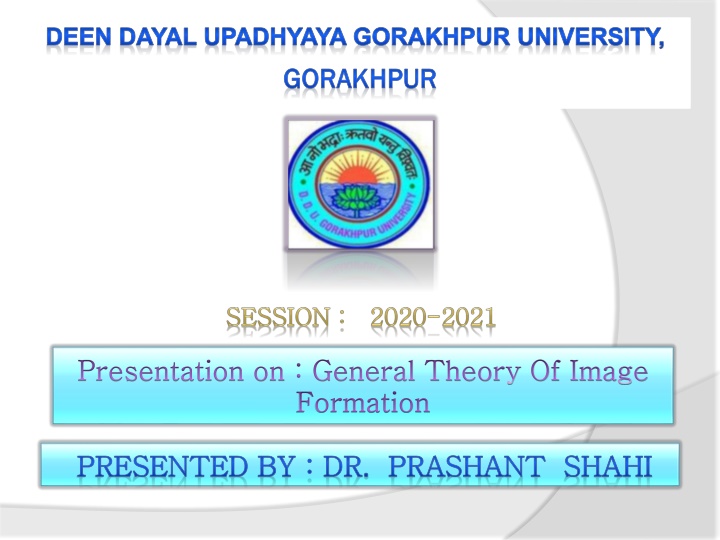
General Theory of Image Formation and Optical Systems
Explore the fundamentals of image formation and optical systems with topics like coaxial optical systems, deviation in thin lenses, and cardinal points. Understand concepts like focal points, principal points, and nodal points to enhance your knowledge in the field. Dive into the world of optics presented by Dr. Prashant Shahi from Deen Dayal Upadhyaya Gorakhpur University.
Download Presentation

Please find below an Image/Link to download the presentation.
The content on the website is provided AS IS for your information and personal use only. It may not be sold, licensed, or shared on other websites without obtaining consent from the author. If you encounter any issues during the download, it is possible that the publisher has removed the file from their server.
You are allowed to download the files provided on this website for personal or commercial use, subject to the condition that they are used lawfully. All files are the property of their respective owners.
The content on the website is provided AS IS for your information and personal use only. It may not be sold, licensed, or shared on other websites without obtaining consent from the author.
E N D
Presentation Transcript
DEEN DAYAL UPADHYAYA GORAKHPUR UNIVERSITY, GORAKHPUR GORAKHPUR Presentation on : General Theory Of Image Presentation on : General Theory Of Image Formation Formation PRESENTED BY : DR. PRESENTED BY : DR. PRASHANT PRASHANT SHAHI SHAHI
CONTENTS CONTENTS 1. Coaxial 1. Coaxial optical system optical system 2. 2. Deviation produced by a thin Deviation produced by a thin lense lense 3. 3. Equivalent focal length of combination of two thin lenses Equivalent focal length of combination of two thin lenses 4. Cardinal 4. Cardinal points of a coaxial optical system of two thin points of a coaxial optical system of two thin lenses lenses
COAXIAL OPTICAL SYSTEM A coaxial optical system consists of two or more lenses seperated from each other by finite distances and having common principal axis .The The position position and an an object object can can be be obtained obtained by by considering lense lense seperately seperately. . and size size of refraction at at each of the the image image of each of considering refraction
1. Focal Points - A pair of points lying on the principal axis of optical system and conjugate to points at infinity are called Focal points. First focal point and first focal plane Second and plane focal point focal second
2. Principal Points - principal axis of the optical system having unit positive linear magnification are called principal points of the optical system. A pair of conjugate points on the BB
3. Nodal Points - A pair of conjugate points on the principal axis of the optical system having unit positive angular magnification are called Nodal points.
DEVIATION PRODUCED BY A THIN LENSE When a light ray are refracted through any lense, they are deviated towards the axes in a convex lense and away from the axes in a concave lense .Let a ray of monochromatic light parallel to the axes be incident of a thin lense of focal length f at a height h .if be the deviation produced by a thin lense then tan = h/f {if is very small} = h/f
EQUIVALENT FOCAL LENGTH OF TWO THIN LENSES Let L1and L2be two thin lenses of focal lengths f1and f2 placed co-axially separated by a distance d in air . Then equivalent focal length of two thin lenses is given by F = f1f2/f1+f2-d
CARDINAL POINTS OF A COAXIAL OPTICAL CARDINAL POINTS OF A COAXIAL OPTICAL SYSTEM OF TWO THIN LENSES SYSTEM OF TWO THIN LENSES Position of second principal point - 2= - Fd/f1 Position of second focal point - 2= F ( 1 d/f1) Position of first principal point - 1= dF/f2 Position of first focal point - 1 = -F (1- d/f2)
